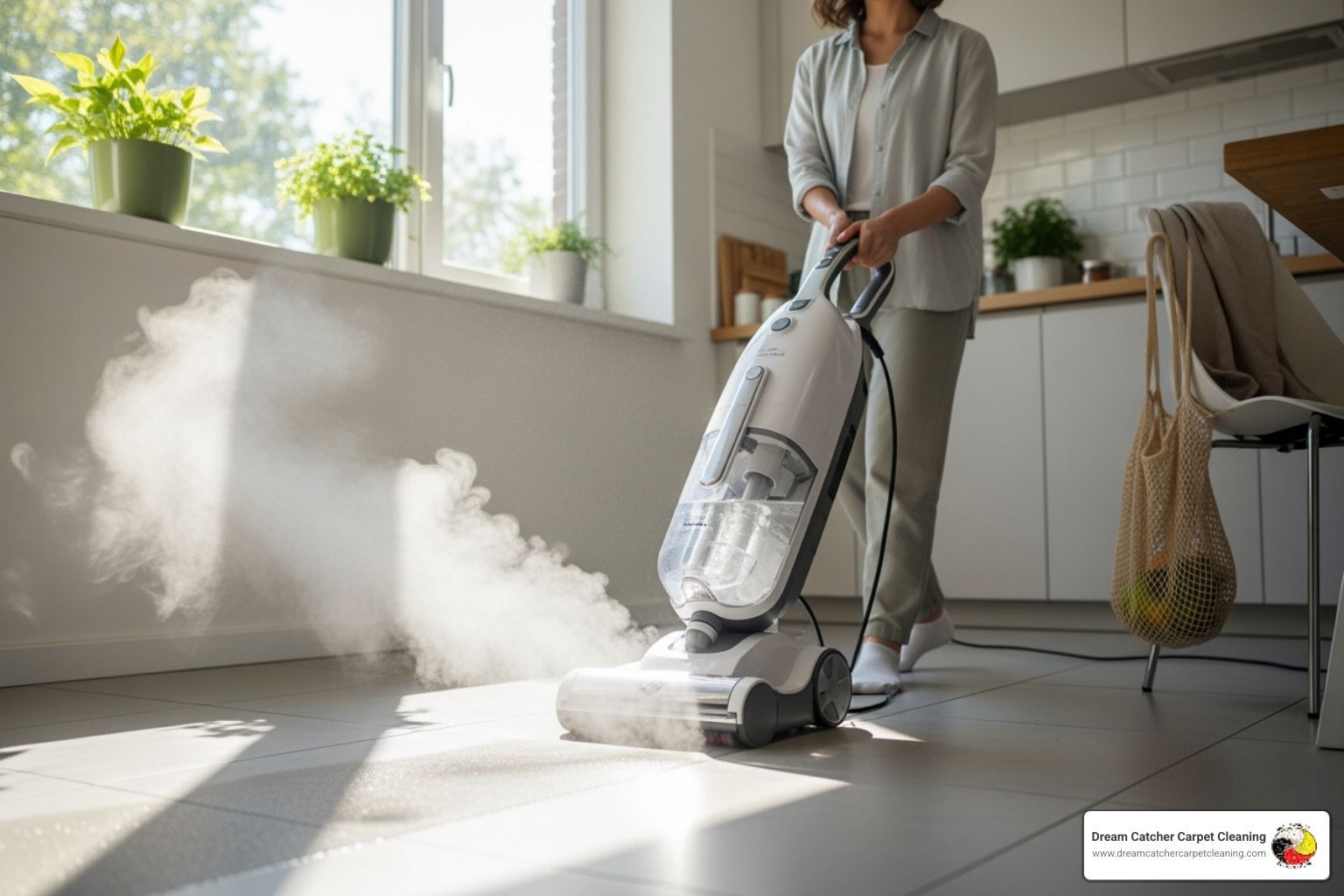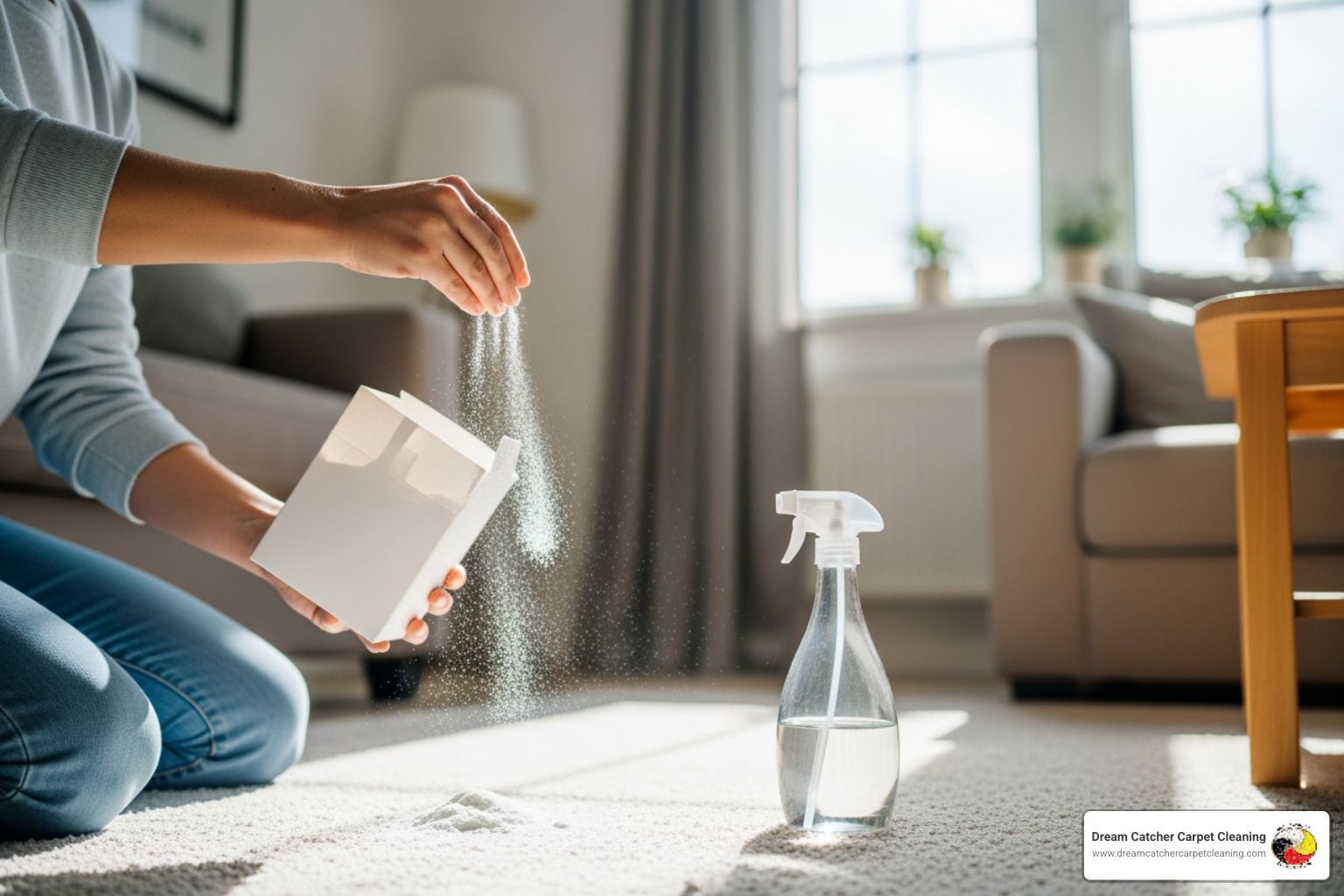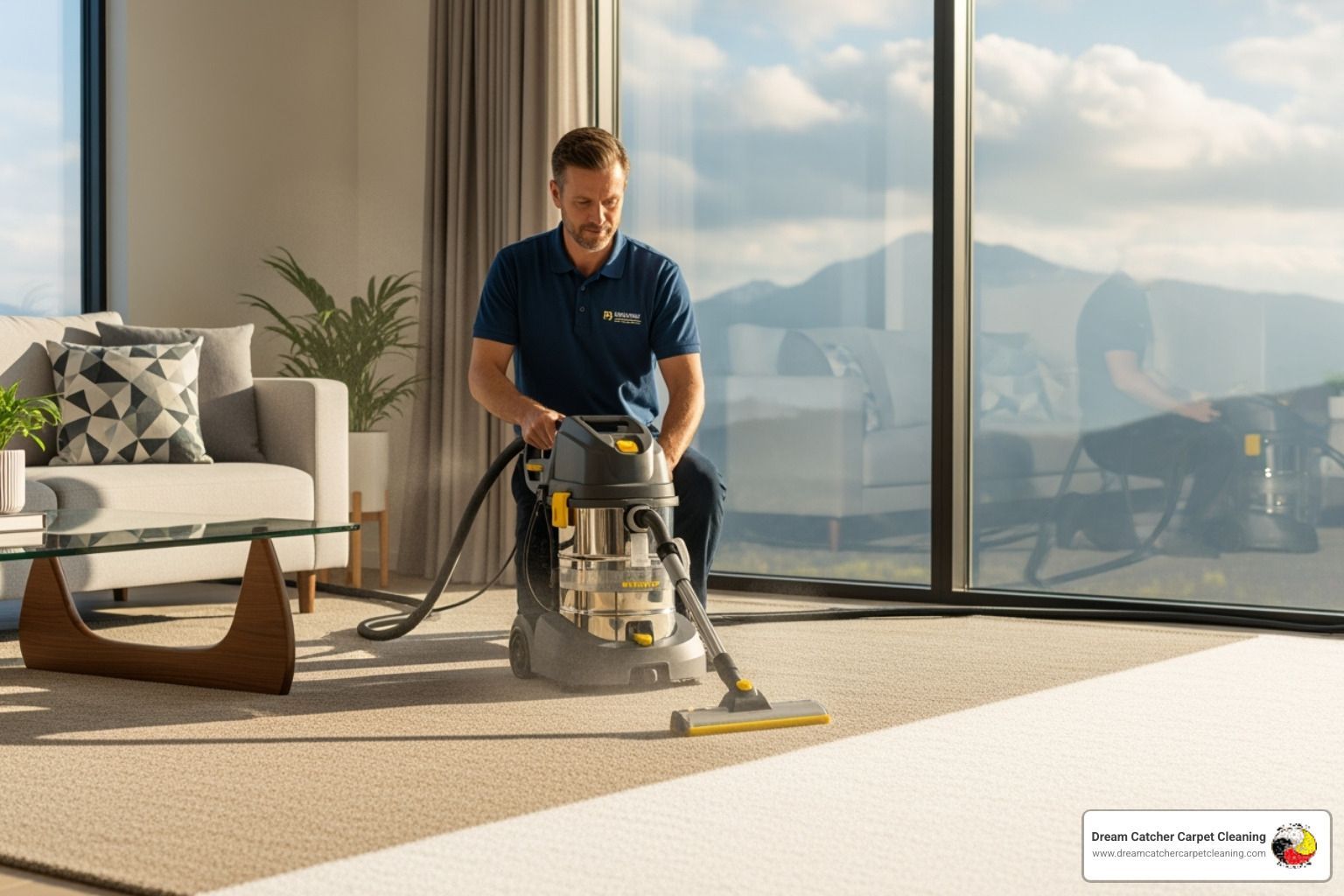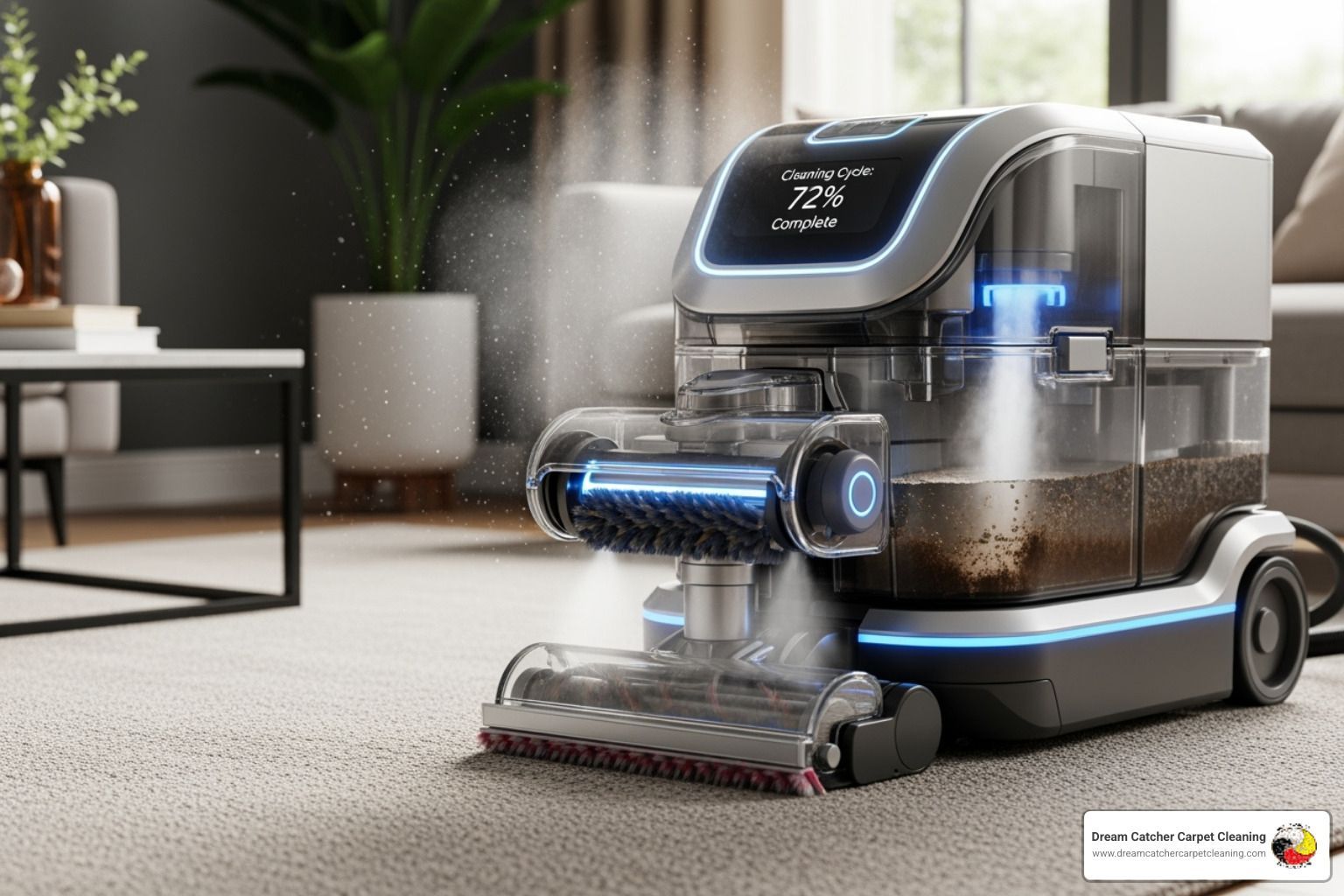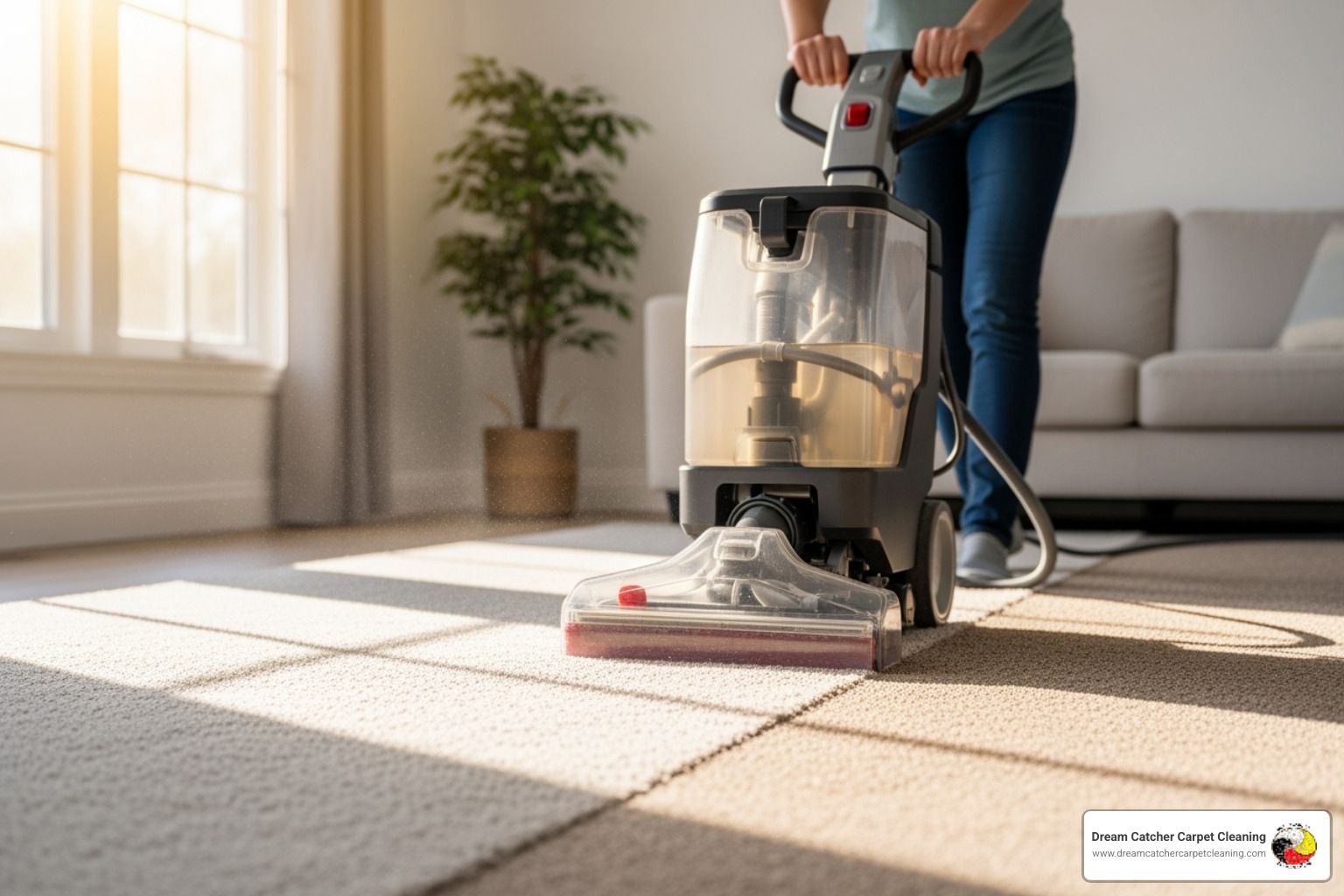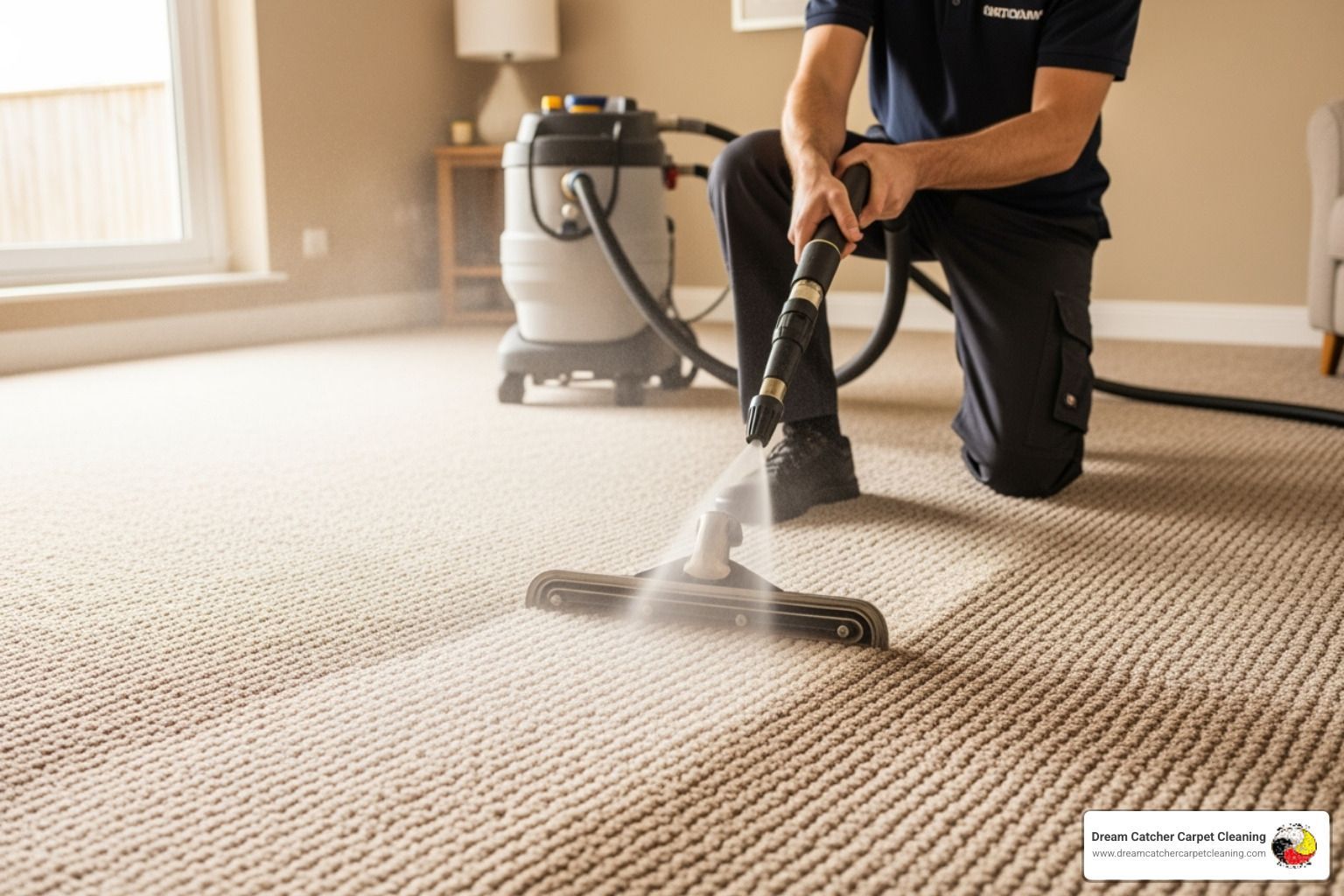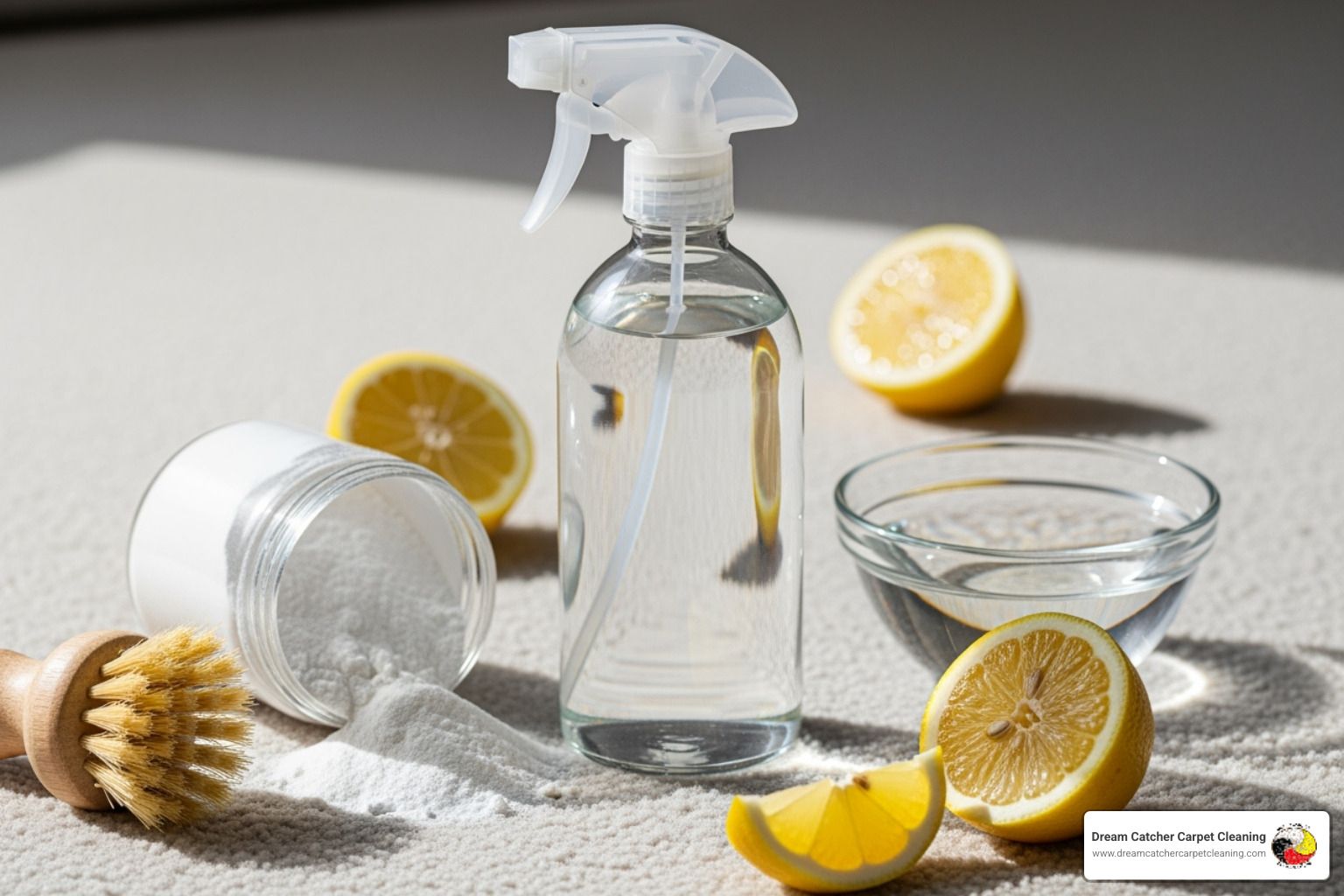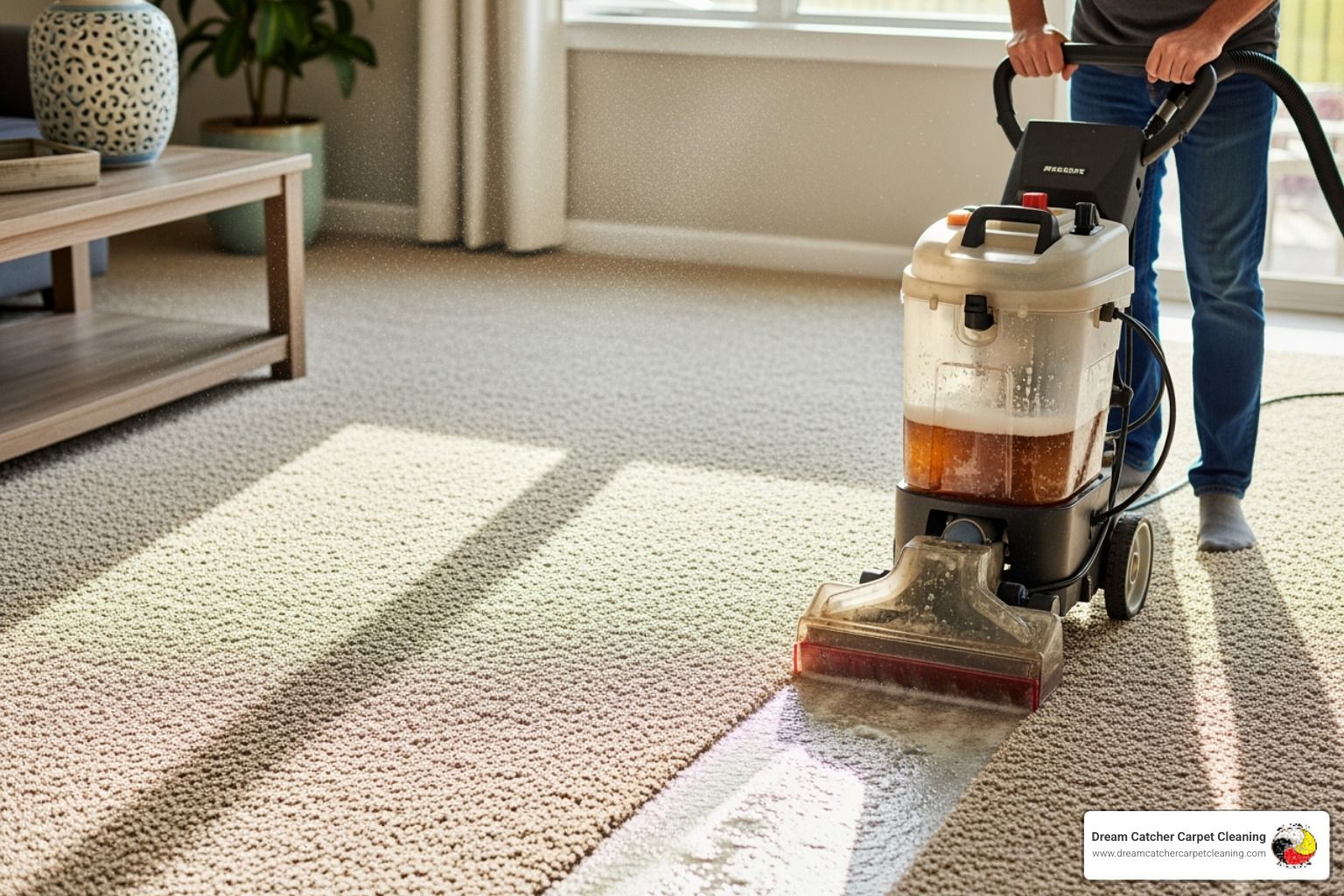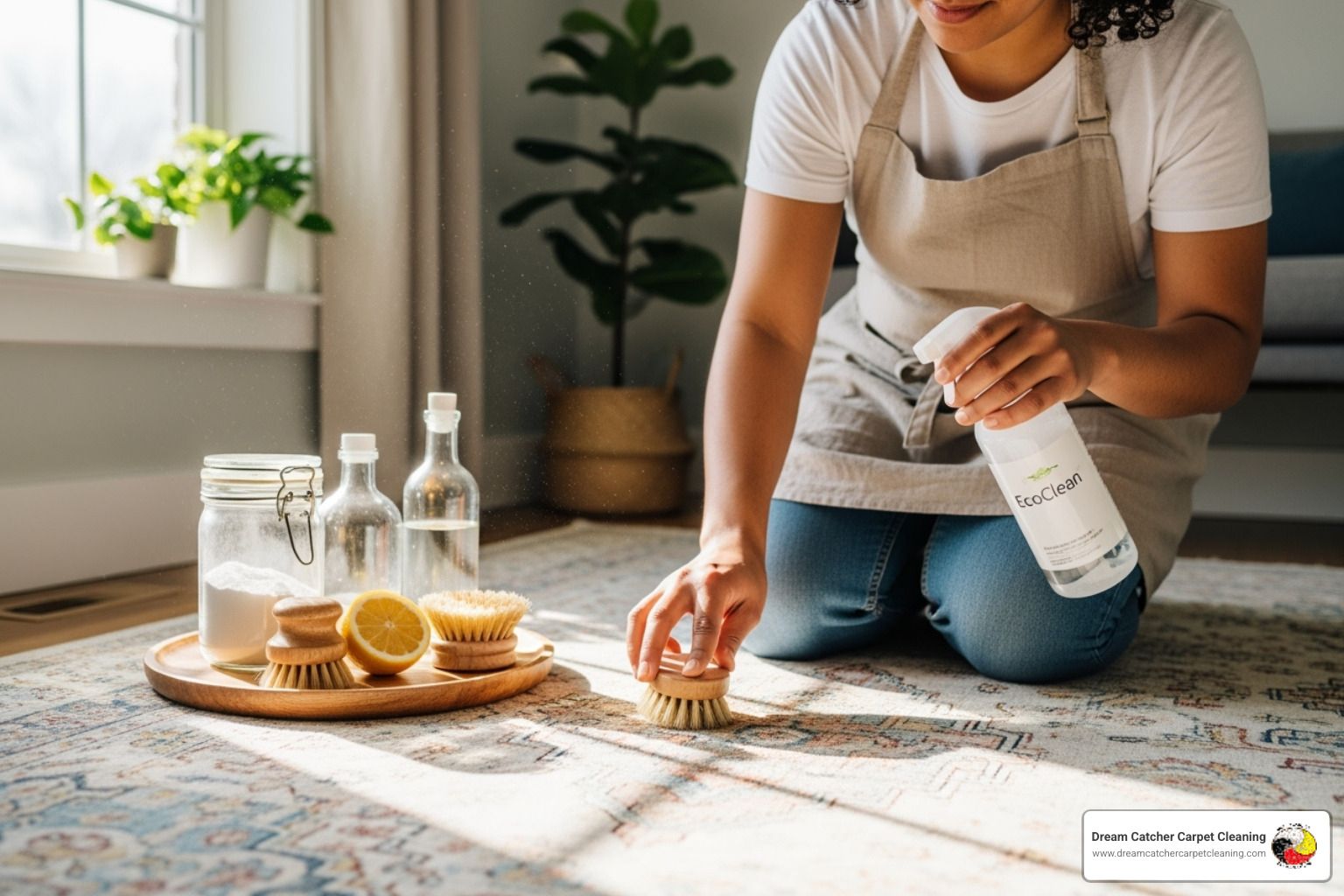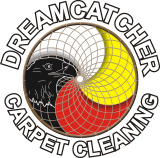Why Natural Pet Stain Removers Are Your Carpet's Best Friend
Natural pet stain remover carpet cleaner solutions offer pet owners a safe, effective way to tackle accidents without harsh chemicals that could harm their furry family members. Whether you're dealing with fresh puddles or stubborn set-in odors, the right natural approach can restore your carpets while keeping your home healthy.
Quick Natural Pet Stain Removal Methods:
- Fresh Stains: Blot immediately, spray with equal parts white vinegar and hydrogen peroxide, let sit 10 minutes, then blot dry
- Set-in Odors: Apply enzyme-based cleaner, keep moist for 30 minutes, reapply if needed, then extract with wet vacuum
- Tough Stains: Sprinkle baking soda first, then apply vinegar-peroxide solution for extra lifting power
- Prevention: Use enzyme cleaners that break down uric acid to prevent pets from re-marking the same spots
As one pet owner finded after spending hundreds on unsuccessful treatments, sometimes the simplest solutions work best - like the soap powder method that finally eliminated months of cat urine odor when expensive commercial products failed.
The beauty of natural cleaning lies in using ingredients you likely already have at home. White vinegar breaks down sticky messes with its natural acidity, while hydrogen peroxide disinfects and kills bacteria. Enzyme cleaners work like biological catalysts, breaking down organic proteins at the molecular level rather than just masking odors.
I'm Clarence Smith, owner of Dream Catcher Carpet Cleaning with over 22 years of experience helping Denver families tackle pet stains using environmentally safe, non-toxic solutions. Throughout my career, I've seen how effective natural pet stain remover carpet cleaner methods can be when applied correctly, often outperforming harsh chemical alternatives while keeping pets and families safe.

Why Choose a Natural Approach?
When your beloved pet has an accident on your beautiful carpet, reaching for the first cleaner you see might seem like the obvious choice. But here's the thing - those harsh chemical cleaners sitting under your sink could actually be making things worse for your family, your pet, and your carpets.
Natural pet stain remover carpet cleaner solutions aren't just a feel-good trend. They're backed by solid science and proven results that we've witnessed in thousands of North Metro Denver homes over the past two decades.
The EPA's Safer Choice certification program puts natural cleaning products through rigorous testing for safety. These products are evaluated for everything from cancer-causing potential to environmental impact. When you choose natural options, you're not just cleaning - you're investing in your family's health while often saving money too.
Think about it this way: your pets spend most of their time close to the ground, breathing in whatever residues remain after cleaning. Natural ingredients break down completely, leaving nothing behind that could harm curious noses or paws.
Health & Environmental Benefits
Walking into a freshly cleaned room shouldn't feel like entering a chemistry lab. Natural cleaning creates genuinely fresh air by eliminating volatile organic compounds (VOCs) that can trigger headaches, respiratory issues, and allergic reactions.
Here's what makes natural cleaners so much better for your indoor air quality: ingredients like white vinegar and hydrogen peroxide break down into harmless water and oxygen. No lingering chemical fumes, no synthetic fragrances masking underlying problems.
Biodegradable surfactants protect our local waterways too. When you rinse natural cleaners down the drain, you're not adding harmful chemicals to Denver's water treatment systems. Plant-based enzymes continue working long after you've finished cleaning, ensuring complete elimination of stains and odors rather than just temporary masking.
We've noticed something interesting over the years - families who switch to natural cleaning consistently report fewer allergy symptoms and better sleep quality. It makes sense when you consider that carpet fibers can hold onto chemical residues for months.
Common Chemical Pitfalls to Avoid
Some conventional carpet cleaners can actually train your pet to have more accidents. Sounds crazy, right? But synthetic fragrances often confuse pets' sensitive noses rather than eliminating the odors that draw them back to the same spot.
Chlorine bleach might lighten stains temporarily, but it damages carpet fibers and creates toxic fumes. We've seen too many beautiful carpets ruined by well-meaning pet parents who thought stronger meant better.
Phosphates create their own problems by leaving behind soap residues that act like dirt magnets. This explains why some spots seem to reappear days after cleaning - you're not imagining it! Those residues actually attract new dirt and pet hair back to the exact same area.
The worst part? Many chemical cleaners just layer new scents over existing odors instead of breaking them down. Your nose might not detect the problem anymore, but your pet's super-sensitive smell receptors definitely can. That's why natural enzyme cleaners that completely eliminate odors at the molecular level are so much more effective for preventing repeat accidents.
The Science Behind a Natural Pet Stain Remover Carpet Cleaner
Ever wonder why your natural pet stain remover carpet cleaner actually works better than those harsh chemical alternatives? It's not magic - it's science! Understanding how these natural ingredients tackle pet messes at the molecular level helps you become a more effective stain-fighting superhero.
The secret lies in how different natural ingredients work together like a well-coordinated team. Enzymes act as the heavy lifters, breaking down proteins and organic matter , while acids and oxidizers provide backup support by neutralizing odors and disinfecting surfaces. Each ingredient has its own special job, which is why combining them creates such powerful cleaning results.

| Cleaner Type | How It Works | Best For | Time Needed |
|---|---|---|---|
| Enzymatic | Digests proteins and uric acid crystals | Set-in stains and persistent odors | 30 minutes to overnight |
| Oxidizing | Releases oxygen to break down stains | Fresh stains and disinfection | 10-15 minutes |
How Enzymes Break Down Pet Messes
Think of enzymes as tiny biological Pac-Mans that munch their way through pet mess proteins. These beneficial bacteria and live enzyme cultures don't just cover up problems - they literally eat the organic matter that causes stains and odors.
Protein digestion happens when enzymes target the complex proteins found in urine, feces, and vomit. They break these large molecules into smaller, harmless particles that rinse away easily. It's like having microscopic janitors working around the clock to clean your carpets.
The real villain in pet accidents is uric acid crystals. These stubborn little troublemakers are what make old pet stains smell terrible, especially on humid days. Chemical cleaners can't touch them, but enzymes dissolve these crystals completely. That's why pets stop returning to the same spot after proper enzyme treatment.
Dwell time is crucial for enzyme success. Unlike instant chemical cleaners, enzymes need time to do their work - typically 30 minutes for fresh stains, but sometimes overnight for really stubborn problems. Patience pays off with complete odor elimination rather than temporary masking.
Oxidizers & Acids: Backup Allies
While enzymes handle the heavy lifting, hydrogen peroxide swoops in as your disinfecting hero. This powerful oxidizer releases oxygen bubbles that break apart stain molecules and kill odor-causing bacteria. The bubbling action you see is actually the cleaner working to lift stains from carpet fibers.
pH neutralization is where white vinegar shines. Pet urine is alkaline, which is why it can damage carpet fibers over time. Vinegar's natural acidity brings the pH back to normal while breaking down sticky residues that attract dirt.
The color-safe whitening effect of hydrogen peroxide helps restore carpet appearance without the harsh bleaching action of chlorine products. Combined with vinegar's residue-removing power, you get both cleaning and restoration in one natural treatment.
Label Reading 101 for a Natural Pet Stain Remover Carpet Cleaner
Shopping for natural cleaners can feel overwhelming, but knowing what to look for makes it simple. Ingredient transparency should be your first clue - legitimate natural products list every ingredient clearly rather than hiding behind vague terms like "proprietary blend."
The Safer Choice logo from the EPA means ingredients have been rigorously tested for safety around humans and pets. The USDA Organic seal takes things further, ensuring ingredients meet strict organic farming and processing standards.
Watch out for sneaky chemicals masquerading as natural. Products containing phosphates, chlorine bleach, or synthetic fragrances aren't truly natural, even if the marketing suggests otherwise. Real natural cleaners use recognizable ingredients like plant-based surfactants and organic acids.
For more detailed guidance on choosing truly effective natural products, check out our comprehensive guide on the Best Eco-Friendly Carpet Cleaner options available today.
Step-by-Step Natural Carpet Cleaning Hacks
Getting pet stains out of carpet doesn't have to feel like rocket science, but knowing the right steps makes all the difference. After two decades of helping Denver families tackle everything from puppy accidents to senior dog mishaps, I've learned that timing and technique beat expensive products every single time.
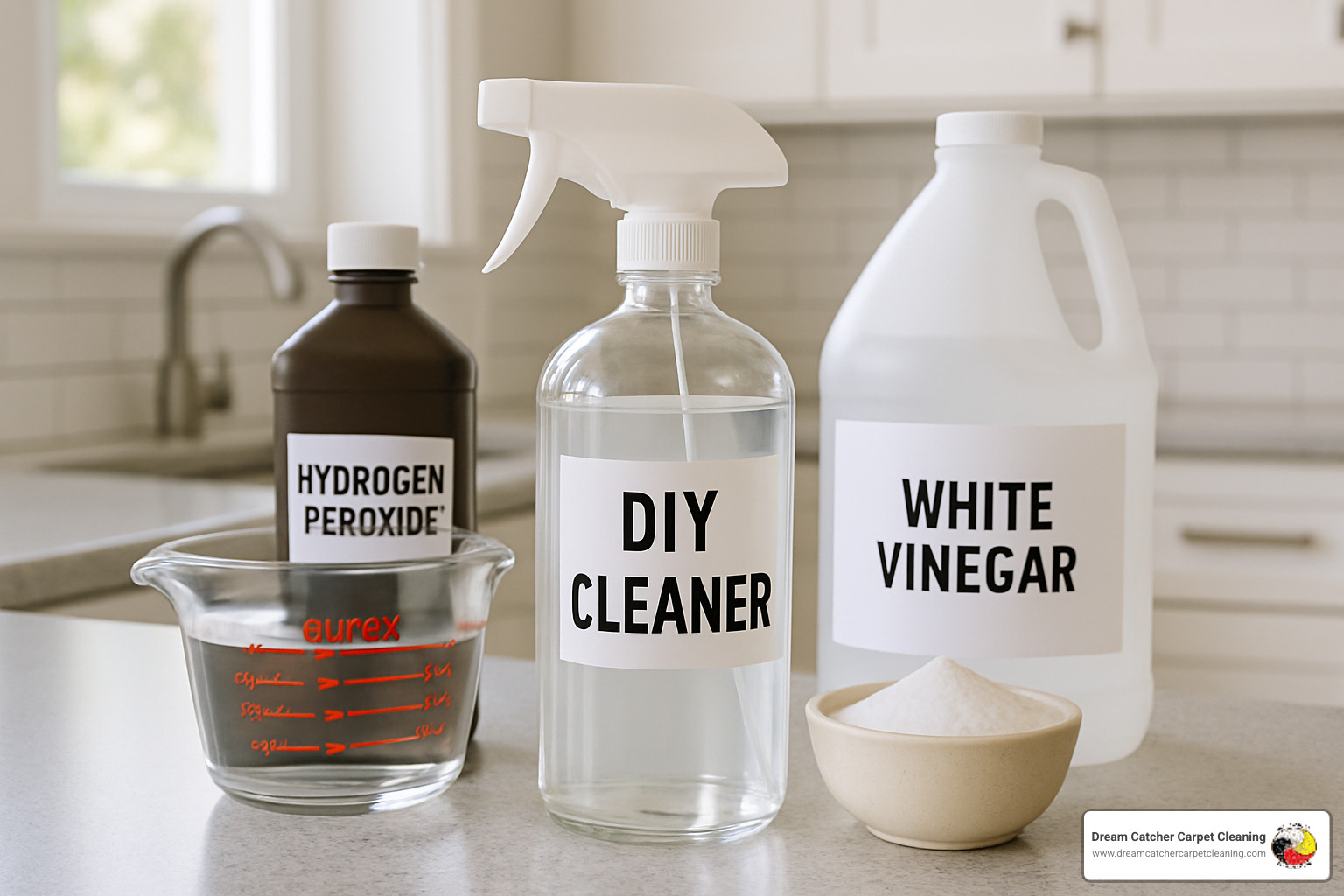
The golden rule? Speed wins the race. Fresh accidents are like spilled coffee - handle them quickly and they're no big deal. Let them sit, and you're dealing with a whole different beast. Always start by blotting up excess liquid with clean towels, working from the outside edges toward the center. This prevents the stain from spreading into a bigger mess.
Fresh stains need immediate attention, while set-in odors require patience and the right natural approach. Don't panic if you find an older accident - natural methods can still save the day, they just need more time to work their magic.
Quick DIY Natural Pet Stain Remover Carpet Cleaner Recipe
Here's the natural pet stain remover carpet cleaner recipe that's saved countless carpets in our service area. It combines hydrogen peroxide's stain-fighting power with white vinegar's odor-neutralizing abilities - think of it as nature's dynamic duo.
Mix these ingredients in a dark spray bottle: half a cup of hydrogen peroxide, half a cup of white vinegar, two cups of warm water, and five to ten drops of lemon essential oil if you want a fresh scent. The dark bottle is important because light breaks down hydrogen peroxide, making it less effective.
For stubborn stains, here's a pro trick: sprinkle baking soda over the stain first, then spray your solution on top. The fizzing reaction you'll see isn't just fun to watch - it's actually lifting the stain right out of your carpet fibers.
This homemade solution tackles fresh stains in about ten minutes and can handle older stains with repeated applications. Store it in a cool, dark place and it'll stay effective for months. Just remember to shake well before each use and always test a hidden area first. More info about DIY Non-Toxic Carpet Cleaner can give you even more recipe variations.
Deep-Clean Method with Enzyme Solution
When you're dealing with serious odor problems or that one spot where your pet keeps having accidents, enzyme treatment is your best friend. It takes longer than quick fixes, but it actually eliminates the problem instead of just covering it up.
The key to enzyme success is keeping things moist. Apply your enzyme cleaner generously - don't be shy about it. The solution needs to stay wet for at least thirty minutes to do its job properly. If it starts drying out, reapply more solution.
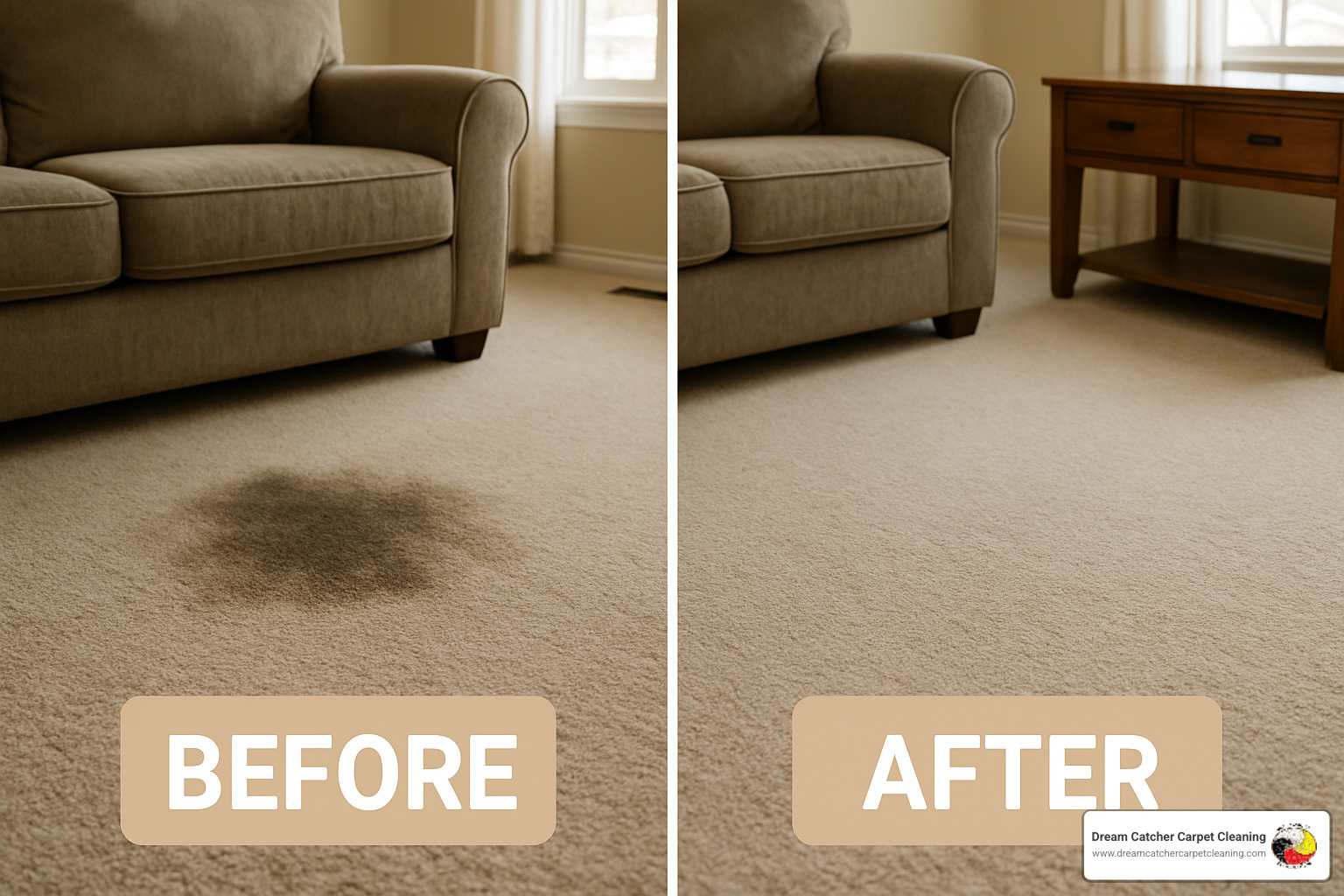
Here's what works best: remove any solid waste first, then blot up excess liquid without rubbing. Apply the enzyme cleaner liberally, covering the entire affected area plus a bit beyond. Keep reapplying every thirty minutes if needed, then let the enzymes work their magic for several hours or overnight.
For really tough cases where odors have penetrated deep into carpet padding, you might need to keep the area moist for up to three days. I know that sounds like a long time, but trust the process - those beneficial bacteria are literally eating the odor-causing compounds.
After the enzyme treatment, extract as much moisture as possible with a wet vacuum or clean towels. Set up fans to speed drying and prevent any mold issues. The wait is worth it when your carpet smells fresh again.
Upholstery & Area Rug Tips
Furniture and area rugs need a gentler touch than wall-to-wall carpeting. Too much moisture can cause fabric shrinkage, color bleeding, or water stains that are worse than the original pet accident.
Always check fabric care codes before treating upholstery - those little tags aren't just decoration. Use minimal moisture by misting with a spray bottle rather than soaking the fabric. Blot immediately with white towels to avoid color transfer.
For area rugs, flip them over after surface treatment to check if moisture has soaked through to the backing. If odors have penetrated all the way through, treat both sides. Just make sure you have good ventilation and fans running - wet rugs can develop mold problems if they don't dry completely within 24 to 48 hours.
Color-fast testing is crucial with delicate fabrics. Apply a tiny amount of your cleaning solution to a hidden corner and blot with a white cloth. If any color comes off, stick to professional cleaning to avoid expensive mistakes.
Pro Tips to Prevent Re-Soiling and Set-In Odors
The best natural pet stain remover carpet cleaner strategy is preventing problems before they become permanent headaches. After two decades of helping Denver families tackle pet accidents, I've learned that smart prevention saves both time and money while keeping your home fresh and welcoming.
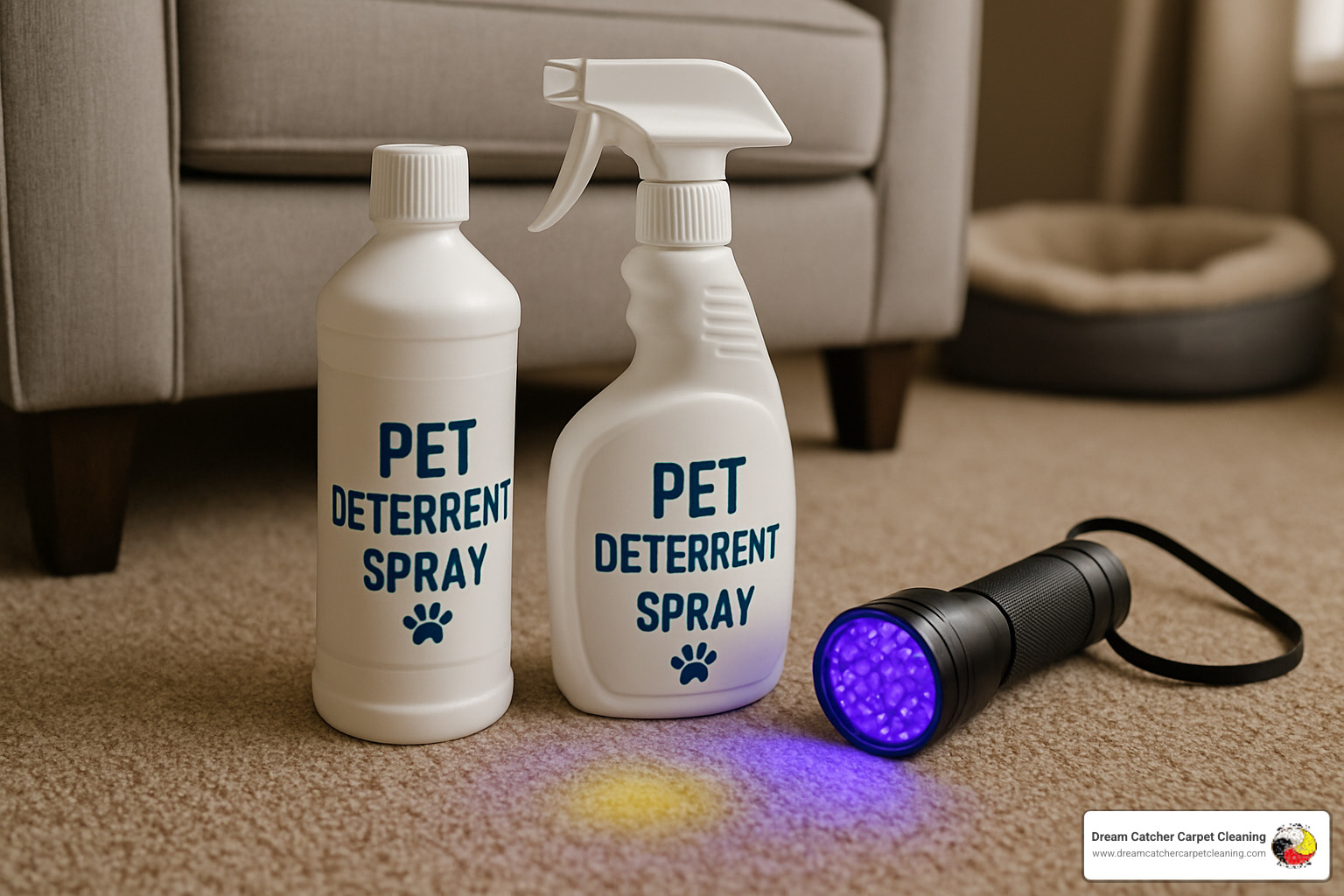
Black-light inspection becomes your secret weapon for finding hidden accidents that create mysterious odors. Pet urine glows bright yellow under UV light, revealing the true scope of damage that's invisible to the naked eye. I recommend checking problem areas monthly - you'll be amazed at what you find lurking beneath the surface.
Mark any glowing spots with chalk so you can treat them thoroughly in normal lighting. This detective work prevents small problems from becoming major odor disasters that require professional intervention.
Barrier sprays create invisible shields that repel future accidents while routine maintenance with enzyme cleaners keeps carpets fresh between deep cleanings. Apply carpet protectant after cleaning to make future spills easier to clean and prevent them from penetrating deep into fibers.
When to Upgrade from DIY to a Professional Natural Pet Stain Remover Carpet Cleaner Service
Sometimes DIY methods reach their limits, and recognizing these situations saves you from wasting time on ineffective treatments. Multiple accidents in the same area create layers of contamination that home equipment simply can't reach, especially when odors have penetrated through carpet padding into the subfloor.
Subfloor penetration requires specialized moisture detection equipment and professional-grade extraction tools that remove far more water and cleaning residue than home methods. When urine soaks through to wooden subfloors, surface cleaning won't eliminate the odor source.
Time constraints also make professional cleaning worthwhile - if you're preparing for house guests or dealing with extensive damage across multiple rooms, professional services restore your carpets quickly and completely. We've helped countless families prepare for holidays and special events when DIY cleaning wasn't fast enough.
Professional hot water extraction sanitizes carpets more thoroughly than surface treatments while removing soap residues that can cause stains to reappear weeks later. More info about Pet-Friendly Carpet Cleaning explains exactly when professional help makes the most financial sense.
Odor-Blocking & Pet Behavior Hacks
Understanding pet psychology is just as important as using the right cleaning products. Pets have incredibly sensitive noses - they can detect trace amounts of uric acid that are completely invisible and odorless to humans. This explains why pets often return to the same spots even after thorough cleaning.
Enzyme re-treatment every few months maintains odor control in problem areas, even when no visible stains exist. Think of it as preventive maintenance for your carpets - applying enzyme cleaner to previously treated spots breaks down any microscopic remnants before they become noticeable.
Pheromone cleaners work differently than regular cleaners by neutralizing the chemical signals that tell pets "this is an appropriate bathroom spot." These specialized products complement enzyme treatments for complete odor elimination.
Don't forget about litter box hygiene and environmental factors that contribute to accidents. Stress, territorial disputes, or simply a dirty litter box can trigger inappropriate elimination behaviors. A training refresh combined with thorough carpet cleaning often solves recurring problems permanently.
The key is addressing both the physical contamination and the behavioral triggers simultaneously. Clean carpets combined with proper pet management create lasting solutions that keep your home fresh and accident-free.
Frequently Asked Questions about Natural Pet Stain Remover Carpet Cleaner
Over my 22 years in the carpet cleaning business, I've heard these questions countless times from worried pet parents. Let me share what I've learned from helping thousands of Denver families tackle their toughest pet stains naturally.
How effective are natural cleaners on old, set-in stains?
Here's the honest truth: natural pet stain remover carpet cleaner solutions can absolutely tackle old stains, but they require more patience than fresh accidents. I've seen enzyme cleaners eliminate odors from carpets that had been problematic for years - but it wasn't a quick fix.
The secret lies in understanding that older stains have had time to crystallize deep in carpet fibers. Those uric acid crystals are stubborn, but enzymes are persistent. You'll need to keep the area moist with enzyme solution for extended periods, sometimes reapplying every 24 hours for several days.
One client called me about a "hopeless" guest bedroom where their elderly cat had been having accidents for months. After three days of intensive enzyme treatment - keeping the carpet damp and reapplying solution twice daily - the odor completely disappeared. The key was patience and not giving up after the first application.
For stains that have penetrated into carpet padding or subfloor, you might need professional extraction equipment to reach those deep deposits. But don't lose hope - I've rarely encountered a stain that proper enzyme treatment couldn't eventually conquer.
Are enzyme formulas safe for puppies and kittens?
This question tugs at my heart because I know how much families worry about their babies - both the furry and human kind. Enzyme cleaners are significantly safer than chemical alternatives, but smart precautions make all the difference.
The beneficial bacteria in quality enzyme products pose no threat to healthy pets. Think of it this way: these are the same types of bacteria that naturally exist in soil and help break down organic matter everywhere in nature.
However, keep treated areas off-limits until completely dry. Puppies and kittens are naturally curious and might try to lick wet surfaces. While enzyme solutions aren't toxic, it's better to be safe than sorry.
One important note for cat families: avoid enzyme cleaners containing essential oils, as some oils can be harmful to felines. Stick with simple, unscented enzyme formulas, and always ensure good ventilation during cleaning.
When in doubt, ask your veterinarian about specific products. Most vets actually recommend enzyme cleaners over harsh chemicals, especially in homes with young or sensitive pets.
Can natural products stop pets from marking the same spot?
This is probably the most important question I get, and the answer can make or break your success with house training. Yes, natural products can absolutely stop repeat marking - but only if they eliminate every trace of odor.
Here's what many people don't realize: your pet's nose is thousands of times more sensitive than yours. Even if you can't smell anything, traces of uric acid crystals are like neon signs saying "bathroom here" to your pet.
Chemical cleaners often mask odors rather than eliminating them , which actually makes the problem worse. Your nose thinks the area is clean, but your pet knows better. This is why some families struggle with the same accident spots over and over.
Enzyme cleaners work differently - they actually digest those uric acid crystals completely. No crystals means no scent markers, which means no reason for your pet to return to that spot.
I always tell clients to combine thorough enzyme cleaning with smart training strategies. Block access to problem areas during retraining, clean accidents immediately with enzyme solution, and reward your pet for using appropriate spots. The combination of complete odor elimination and positive reinforcement usually solves even stubborn marking problems.
One family had been battling their dog's favorite corner spot for two years. After one thorough enzyme treatment followed by consistent training, the problem never returned. Sometimes the solution really is that straightforward.
Conclusion
Taking care of pet accidents doesn't have to mean filling your home with harsh chemicals that make you worry about your family's safety. Natural pet stain remover carpet cleaner solutions prove that gentle can be just as powerful - often more so - than their chemical counterparts.
The beauty of natural cleaning lies in its simplicity and effectiveness. White vinegar, hydrogen peroxide, and enzyme cleaners work together to break down stains at the molecular level , eliminating odors completely rather than just masking them. When you understand the science behind these natural ingredients, you can tackle any pet mess with confidence.
Fresh accidents respond beautifully to immediate treatment with simple vinegar-peroxide solutions, while stubborn set-in stains surrender to patient enzyme therapy. The key is matching your approach to the problem - and remembering that natural methods reward patience with lasting results.
Prevention makes all the difference in maintaining a fresh, clean home. Regular maintenance with natural cleaners, immediate response to accidents, and understanding your pet's behavior patterns create an environment where both two-legged and four-legged family members can be comfortable.
Sometimes, though, life gets overwhelming. Multiple accidents, deep subfloor penetration, or simply not having enough hours in the day can make professional help the smart choice. That's where Dream Catcher Carpet Cleaning steps in for North Metro Denver families who want professional results with the same natural, eco-friendly approach they'd use at home.
Our 22 years of experience have taught us that the most effective cleaning solutions are often the gentlest ones. We combine commercial-grade equipment with natural cleaning products because we believe your family deserves carpets that are both beautifully clean and completely safe.
More info about Green Carpet Cleaning Services can help you explore whether DIY natural methods or professional eco-friendly services work best for your family's unique needs. Either way, you're choosing health, safety, and effectiveness over harsh chemicals and temporary fixes.
Your pets brought joy into your home - their accidents don't have to bring stress. With natural cleaning methods, you can handle any mess while keeping your family safe and your carpets beautiful for years to come.

